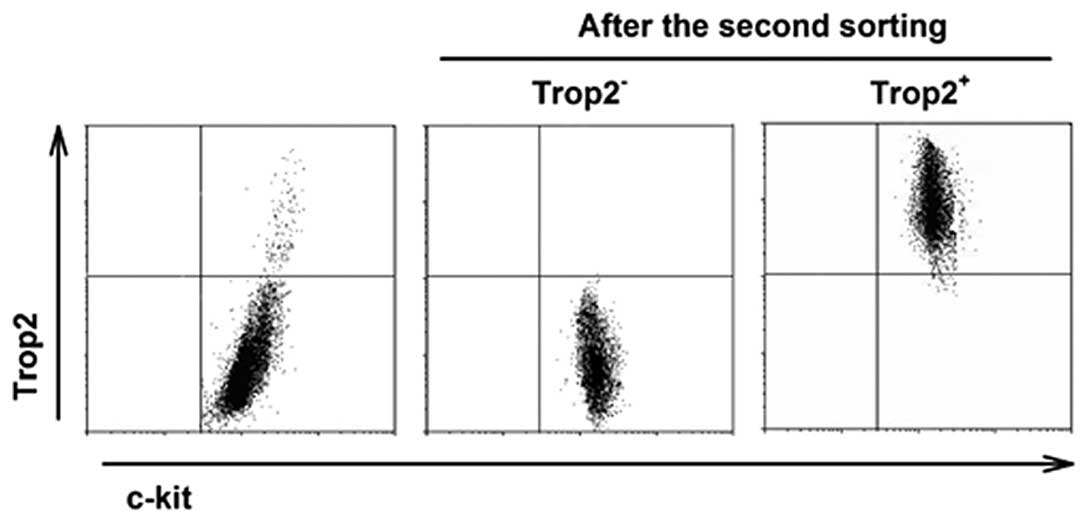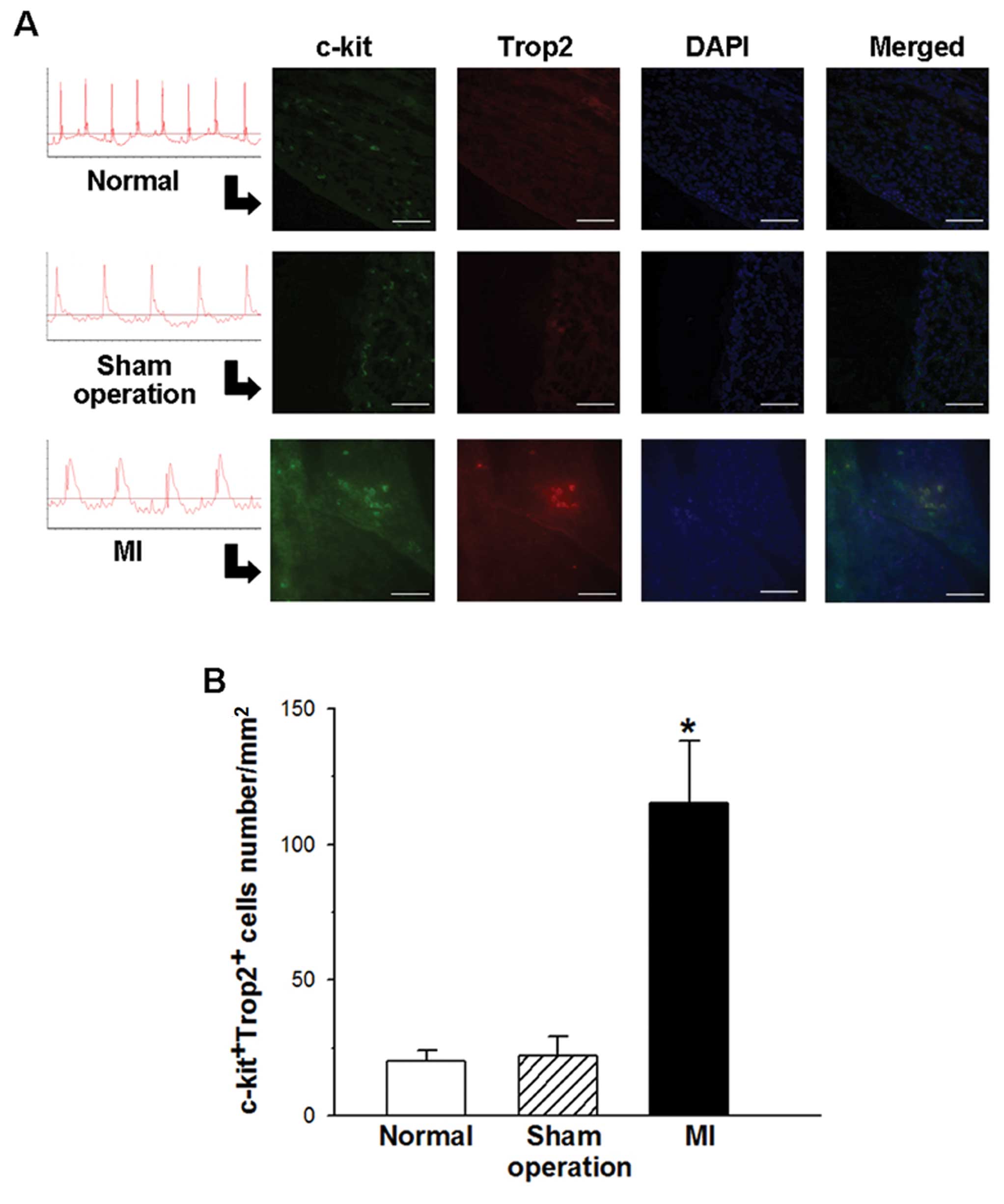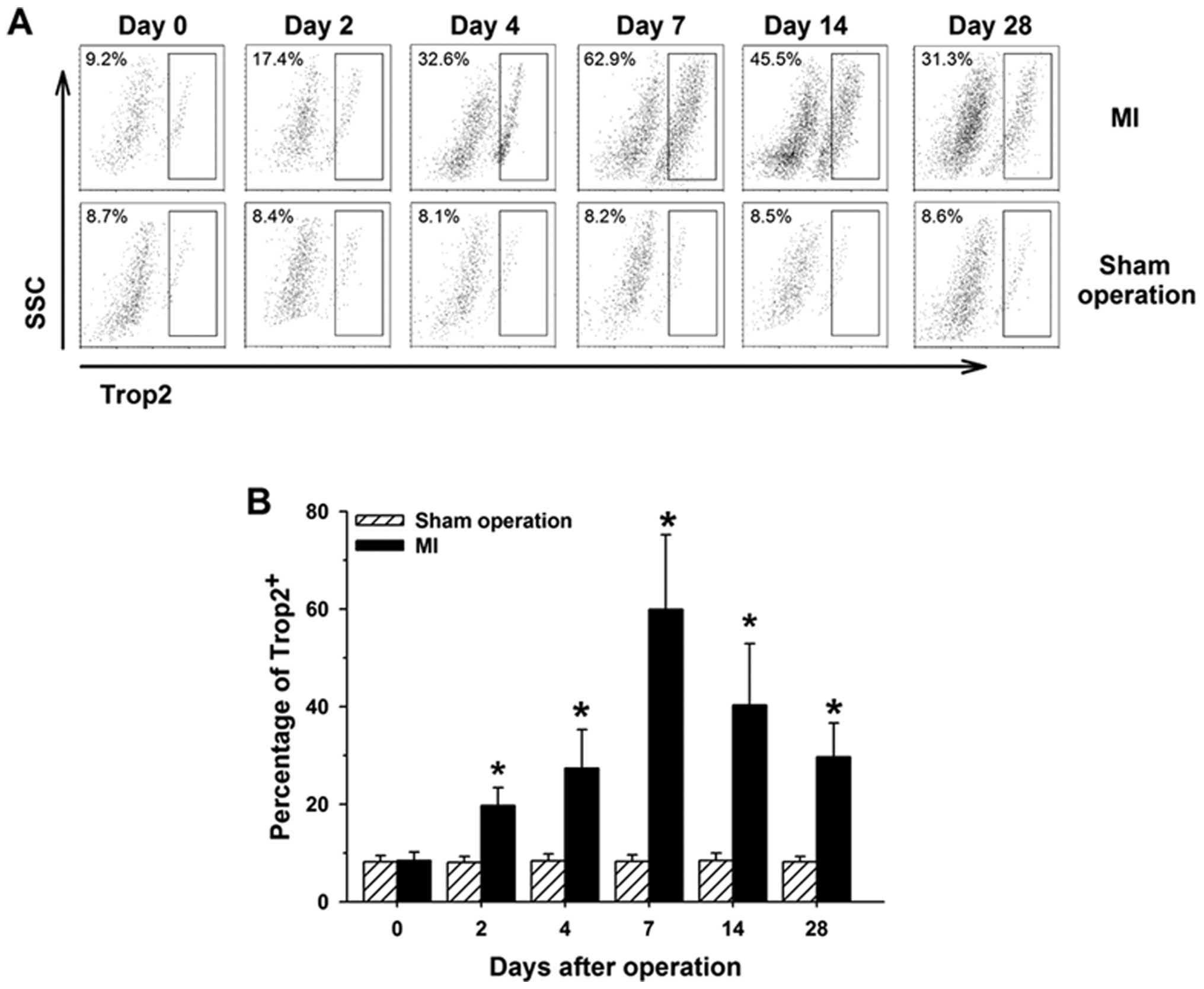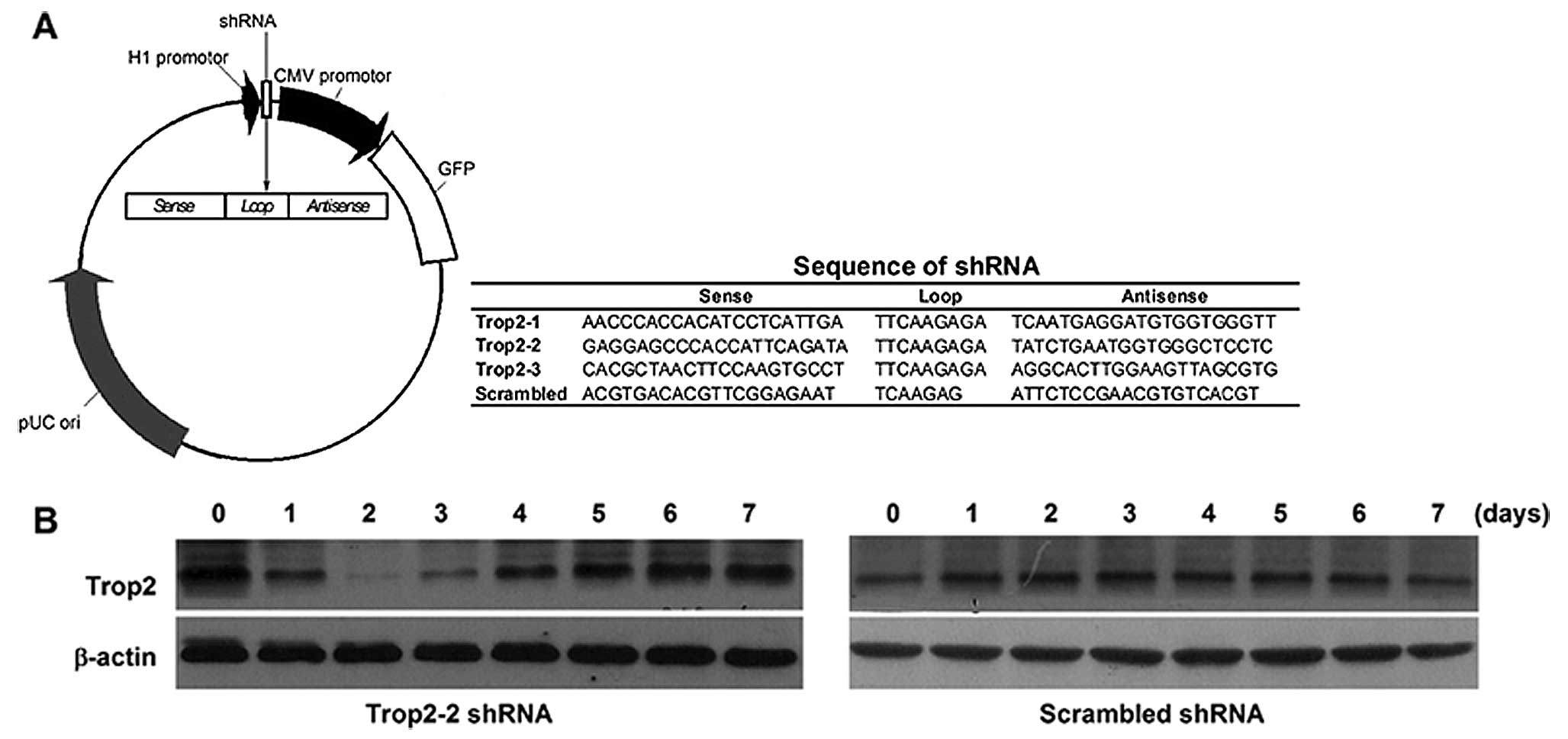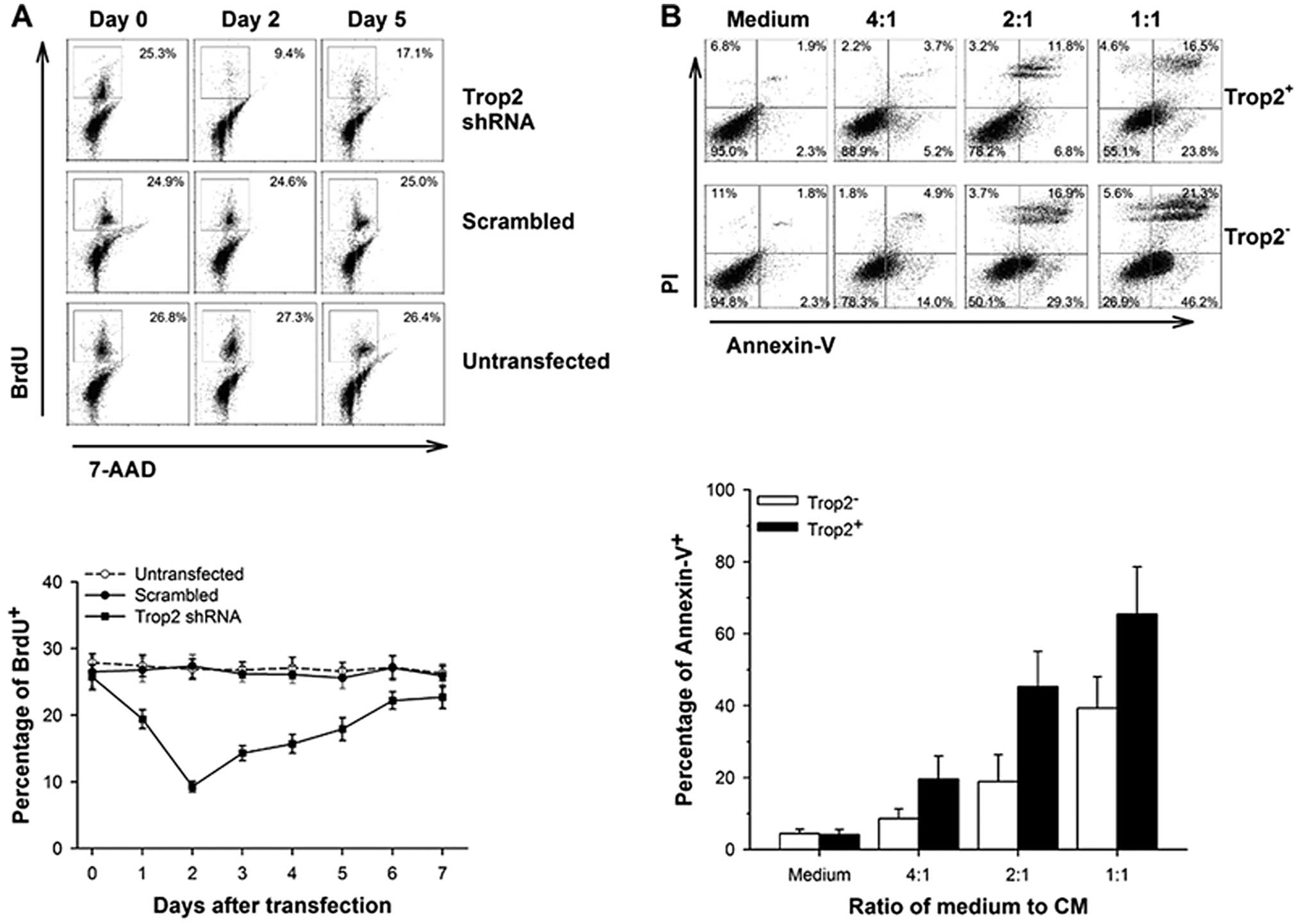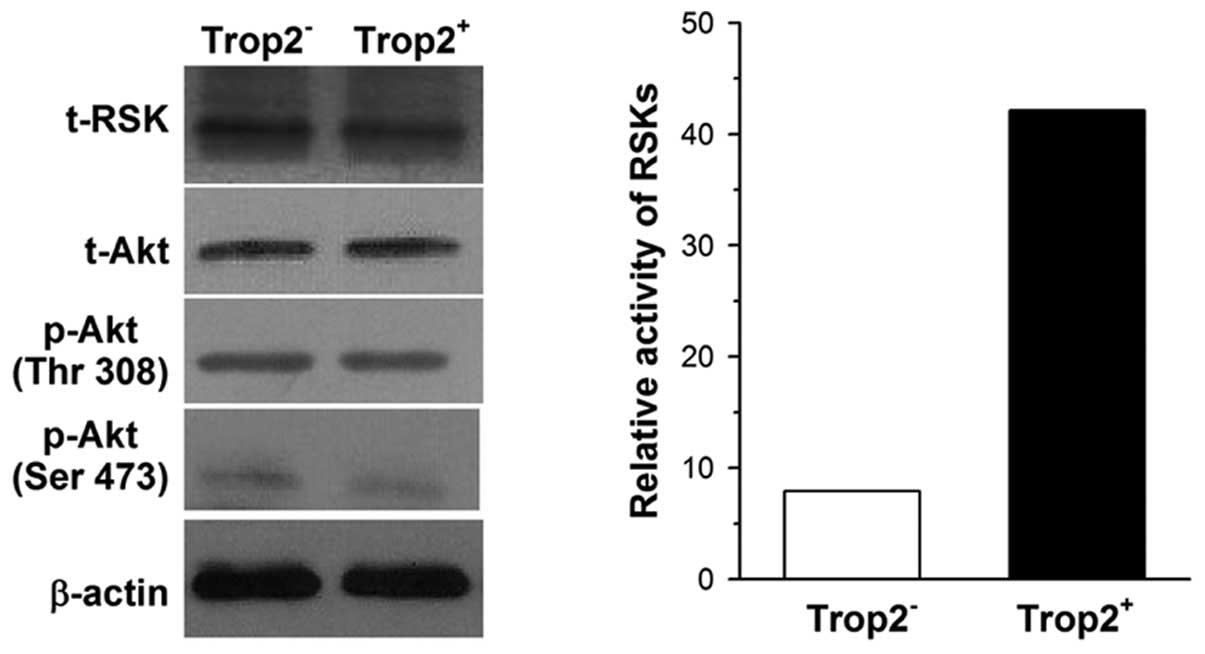Trop2 plays a cardioprotective role by promoting cardiac c-kit+ cell proliferation and inhibition of apoptosis in the acute phase of myocardial infarction
- Authors:
- Published online on: April 5, 2013 https://doi.org/10.3892/ijmm.2013.1332
- Pages: 1298-1304
Abstract
Introduction
Trop2 is a cell-surface glycoprotein first identified in trophoblast cells almost 30 years ago (1). It has been shown that Trop2 plays an important role in the survival, metastasis and aggressiveness of cancer cells (2–9). Previous reports indicated that Trop2 is also highly expressed in hepatic oval cells which are considered to be facultative hepatic stem cells and prostate basal cells with stem cell characteristics (10,11). It appears that Trop2 may provide signals to cancer cells with requirement for proliferation as well as to stem-like cells.
Previous studies found that Trop2 was similar to integrins since both transduce signals through an increase in cytoplasmic Ca2+ (12), as the function observed in other progenitor cells, leading us to investigate the relationship between cardiac progenitor cells (CPCs) and Trop2.
Herein we report that Trop2+ cells represent a minor subpopulation of c-kit+ cells in healthy adult hearts, but the subset increases following acute myocardial infarction (AMI). Trop2 activation enhances c-kit+ cells survival ability in vitro, and the mitogen-activated protein kinase (MAPK) pathway may respond to the potential molecular mechanism underlying this effect.
Materials and methods
Mice
The mice (C57BL/6J) were maintained in certified SPF facilities and the experiments were approved by the Ethics Committee of Animal Use for Teaching and Research, Tongji Medical College of Huazhong University of Science.
Myocardial infarction (MI) was induced in male mice at 12 months (26–28 g) by permanent ligation of the left anterior descending (LAD) coronary artery as previously described (13). Briefly, mice were anaesthetized by intraperitoneal injection with chloral hydrate (Sigma-Aldrich, St. Louis, MO, USA) 300 mg/kg body weight and scopolamine hydrobromide (Sigma-Aldrich) 3 mg/kg body weight, respectively. Following thoracotomy, an 8/0 polypropylene monofilament suture (Jinhuan, Shanghai, China) was tightened around the proximal LAD artery. Sham-operated mice underwent the same surgical procedure without tying the suture but moving it behind the LAD artery. Electrocardiogram (ECG) was performed to verify the presence of MI.
Isolation of cardiac c-kit+ cell subpopulations
Cardiac c-kit+/Trop2+ and c-kit+/Trop2− cells were isolated from the hearts of the mice at 12 months (26–28 g) by two-step immunomagnetic microbead-based cell sorting, according to the manufacturer’s instructions (Miltenyi Biotec, Bergisch Gladbach, Germany). First, a modified procedure was performed to isolate cardiac c-kit+ cells as we previously described (14). Cells were stained with goat anti-Trop2 antibody (Santa Cruz Biotechnology, Inc., Santa Cruz, CA, USA) and rat anti-goat immunomagnetic microbeads (Miltenyi Biotec) for separation of c-kit+/Trop2+ and c-kit+/Trop2− cells. The harvested cells were maintained in the same condition as described above, and the purity of fractioned populations was assayed using flow cytometry.
Trop2 shRNA vector construction and transfection
Mouse Trop2 short hairpin RNA (shRNA) plasmids were constructed by Genechem (Shanghai, China). The validated target sequences were designed according to the cDNA sequences of mouse Trop2 (GenBank accession no. NM_020047). Each anti-Trop2 target sequence corresponds to nt 300–318, 549–567 and 688–706 of Trop2 cDNA sequences. A scrambled shRNA sequence which was not present in the murine or human genome databases was used as a negative control. The schematic diagram of shRNA-expressing plasmid vector together with target sequences is shown in Fig. 3B. The DNA sequences of 4 shRNA plasmids were confirmed by sequencing.
c-kit+/Trop2+ cells grew in 6-well plates to 70% confluence. Five micrograms of each shRNA plasmid diluted in 0.5 ml of Opti-MEM® (Gibco-BRL, Grand Island, NY, USA) were mixed thoroughly with 7.5 μl of PLUS™ reagent (Life Technologies, Rockville, MD, USA) and incubated at room temperature for 5 min. Then, 22.5 μl of Lipofectamine™ LTX (Life Technologies) was added, and the mixture was incubated at room temperature for 30 min. The cells were incubated at 37°C in a CO2 incubator and culture medium was changed after 6 h. The silencing efficiency of Trop2 was monitored with western blot analysis every day for a week.
Western blot analysis and kinase assay
Western blot analysis was performed to assay the silencing efficiency of transfected cardiac c-kit+/Trop2+ cells and the expression level of downstream effectors of signaling pathways. For the latter, isolated Trop2+ and Trop2− cardiac c-kit+ cells were washed once with serum-free DMEM/F12 medium and then returned to the same medium for 24 h prior to stimulation with 10% FCS for 30 min. Cells were lysed and the membranes were incubated with the primary antibodies in optimized dilution, including goat-anti-mTrop2 antibody, and rabbit-anti-Rsk antibody (Santa Cruz Biotechnology, Inc.), anti-Akt antibody, anti-phospho-Akt antibody phosphorylated at Thr308 and at Ser473 (all from Cell Signaling Technology, Beverly, MA, USA). Anti-β-actin (Sigma-Aldrich) was used as a loading control.
Immunoprecipitation kinase assay was performed to detect the activity of Rsks as described by Shimamura et al (15). The cleared lysates from Trop2− and Trop2+ cells were incubated with the Rsk antibody for 3 h, then incubated for an additional hour with 50% slurry of Protein-A-Sepharose beads (Sigma-Aldrich) in PBS. The beads were washed and the kinase assay was performed as described (16). Reactions were subjected to SDS-PAGE on 12% gels and quantitation was performed by phosphorimaging.
Flow cytometric analysis
Hearts were extracted from mice at different time points following MI or sham operation. Using small cells (<40 μm) isolated from 2 hearts, each independently after digestion and sequential filtration, we stained cells with a dual-color antibody panel composed of phycoerythrin (PE) conjugated anti-mouse Abs c-kit (eBioscience, San Diego, CA, USA) and allophycocyanin (APC) conjugated anti-mTrop2 (R&D Systems, Minneapolis, MN, USA) or with single PE conjugated anti-mouse Abs c-kit only for different purposes. Data were collected on a BD LSR II and a number of 1×107 live events based on the viability dye 7-amino-actinomycin D (7-AAD) (BD Biosciences) negative staining were processed for each test. An experiment using endothelial isolated from hearts of neonatal mice negative for c-kit and Trop2 demonstrated minimal non-specific labeling with the antibodies used. Data analysis was performed with standard CellQuest software (version 3.4; BD Biosciences).
For the cell proliferation assay, the transfected cardiac c-kit+/Trop2+ cells were harvested following incubation with 10 μM bromodeoxyuridine (BrdU) and the incorporated BrdU was revealed using APC anti-BrdU antibody according to the BrdU Flow kit (BD Biosciences). To assess apoptosis in vitro, the isolated cardiac c-kit+/Trop2+ and c-kit+/Trop2− cells were incubated in the conditioned media (CM) derived from supernatant of LPS-stimulated monocytes and DMEM/F12 containing 10% FCS in different ratios for 6 h prior to apoptosis assay using Annexin V-APC/propidium iodide (PI) staining according to the manufacturer’s instructions (BD Biosciences). Data were acquired and analyzed as described above.
Statistical analysis
All data are expressed as the mean ± SD. Significance between two comparisons was determined by Student’s t-test and among multiple comparisons by Bonferroni test. P<0.05 was considered to indicate statistically significant differences.
Results
Trop2 is expressed in c-kit+ cells within the myocardium and is increased in post-infarct mouse hearts
The experimental MI C57BL/6J mouse model was inducted to investigate the cellular regulation of the cardiac Trop2 receptor in response to acute ischemia injury. Under ECG monitoring, the successful MI model characterized with the ST-segment rose immediately after LAD ligation and kept elevating during the procedure. Seven days after MI, immunofluorescence staining was performed on heart sections of surviving mice using Trop2 specific Abs combination with c-kit. The density of the c-kit+ cells in the MI heart was greater than in the heart without MI. Moreover, Trop2 was only detected in c-kit+ cells (Fig. 1A). Compared with sham operation and normal hearts, the frequency of c-kit+/Trop2+ cells was much higher in MI hearts (Fig. 1B).
To quantify the rate change of c-kit+/Trop2+ cells during the natural history of MI, all the cells were isolated from the hearts of mice 0, 2, 4, 7, 14 and 28 days after the surgical procedure. We collected the isolated heart cells for dual-color fluorescence flow cytometry analysis. The percentage of c-kit+/Trop2+ cells dramatically increased and was maximal at 7 days after MI, then slightly decreased with time. The c-kit-gated events increased with time following MI. However, the percentage of c-kit+/Trop2+ cells or the total number of c-kit+ cells presented no obvious change at different time points in sham-operated control animals (Fig. 2). Notably, the change trend of c-kit+/Trop2+ cells was consistent with the infiltration pattern of inflammatory cells in border zone of infarcts during the natural history of MI (17), suggesting that the Trop2 receptor may play a critical role in response to acute inflammatory reaction following MI.
Isolation of high purity cardiac c-kit+ cell subpopulations and silencing Trop2 of c-kit+/Trop2+ cells
To ensure lineage-negative state, the two subpopulations were isolated from healthy hearts. With two-step immunomagnetic microbead-based cell sorting, the purity of sorted Trop2 positive cells was >95% and of negative cells almost 100% after the second round of immunomagnetic selection (Fig. 3).
Constructed plasmid vectors transcribing shRNA against Trop2 under H1 promoter (Fig. 4A) were generated and transduced to the c-kit+Trop2+ cells between 0–2 passages. By monitoring the silencing efficiency every day with the detection of GFP (green fluorescent protein) expression, we found that Trop2 was downregulated only using Trop2-2 shRNA plasmid vector. The Trop2 expression decreased to the minimum on the second day after transfection of Trop2-2 shRNA plasmid vector, but returned to the basal line within one week. However, there was no significant silencing efficiency when using scrambled shRNA (Fig. 4B).
Inhibition of Trop2 significantly suppresses proliferation of cardiac c-kit+Trop2+ cells in vitro
To clarify whether Trop2 affects the proliferation of cardiac c-kit+ cells, we measured the BrdU incorporation following shRNA plasmid vectors transfected into c-kit+/Trop2+ cells. BrdU incorporation correlated with the expression of Trop2 in 2% FCS serum conditions (Fig. 5A). The percentage of BrdU positive cells decreased to the lowest at 9.3±0.8% on the second day, while the values were 25.7±1.9 and 22.7±1.7% at 0 and 7 days, respectively, after transfection of vector expressing Trop2 shRNA. However, cells that were transfected with scrambled shRNA plasmid vectors or that were untreated showed invariable growth rate. These results show that downregulation of Trop2 significantly impairs the proliferation of cardiac c-kit+ cells.
c-kit+/Trop2+ cardiac cells are more resistant to inflammatory cytokines in vitro
We performed Annexin V assay to identify whether Trop2 inhibits apoptosis in cardiac c-kit+ cells in MI. Purified Trop2+- or Trop2−-c-kit+ cells were both treated with CM at 0, 1:4, 1:2 and 1:1 ratio (vol vs. vol) respectively, related to DMEM/F12 medium in vitro and apoptosis examined at 6 h post-treatment. The percentage of Trop2+ and Trop2− cell apoptosis were similar in the absence of CM. Although a positive correlation between the ratio of medium to CM and the rate of apoptosis exists in both Trop2+ and Trop2− subpopulations, the latter displays a stronger upward trend (Fig. 5B). These data highlight the crucial role of Trop2 in inhibiting cardiac c-kit+ cell apoptosis mediated by inflammatory cytokines.
Activation of MAPK cascades is responsible for protection of c-kit+ cells by Trop2
In the present study, we focused on the MAPK and phosphatidylinositol 3-OH kinase (PI3K) pathways, since both of them are involved in promoting proliferation and inhibiting apoptosis, and Ca2+ serves as a model in these cascades (18). We measured the activity of ribosomal S6 kinases (RSKs) and the level of phosphorylated Akt in cardiac c-kit+ cells as they are downstream effectors of the MAPK and PI3K pathways, respectively. Cell lysates from Trop2+ and Trop2− cells were immunoprecipitated with RSK antibody and bacterially expressed glutathione-S-transferase (GST)-conjugated substrate GST-S6 as described by Shimamura et al (15). Immune-complex kinase assays confirmed RSK kinase activity in Trop2+ cells is approximately 3.7-fold compared with Trop2− cells. However, there was no significant difference in total-Akt or phosphorylated Akt expression between Trop2+ and Trop2− cells when their lysates were subjected to western blot analysis, whether the phosphorylation site was located on Ser473 or Thr308 (Fig. 6). These results suggest that the MAPK rather than the PI3K signaling pathway corresponds to Trop2 activation in cardiac c-kit+ cells.
Discussion
In the present study we demonstrated that c-kit+ cells exclusively express Trop2 in cardiomyocytes. c-kit+/Trop2+ cells are rarely detected in normal myocardium, but its frequency increases significantly following MI. Decreased expression of Trop2 cardiac c-kit+ cells weaken its ability of proliferation and survival response to the inflammation in vitro. The pathway responsible for Trop2 signal transduction may be the MAPK cascade.
In general, Trop2 expression is only associated with aggressive malignant tumor behavior. Evidence of this hypothesis was found in two organs (prostate and liver) with high regenerative capability. In the prostate, only the basal cells expressing high levels of Trop2 were able to efficiently form spheres in vitro and regenerate prostatic tubules in vivo (11), and in the liver, Trop2 was exclusively expressed on activating oval cells, but was not detected in normal state (10). Our data after experimental MI in mice also support this possibility. Furthermore, the current study shows Trop2 is exclusively present in c-kit+ cells in the heart, which is similar to the liver since oval cells were reported to express c-kit (19), indicating that Trop2 is involved in the regulation of the biological behavior of c-kit+ cells.
The recognition that a pool of undifferentiated cells expressing stem cell surface antigens c-kit, Sca-1, MDR1 and Isl-1 reside within the adult myocardium and that these cells form myocytes, smooth muscle cells and endothelial vascular cells has challenged the traditional concept of the heart as a postmitotic organ (20). It has been demonstrated these cells are involved in repairing damaged myocardium (21,22) and cardiac c-kit+ cells may be more relevant in emergencies than other CPCs (20). However, in most cases, the resident CPCs are insufficient for rejuvenating cardiac performance of injured heart. The reasons for this limited effect of self-repair of the heart may be the rare number and intrinsic properties of CPCs. Moreover, high oxidative stress in damaged myocardium, such as infarcted lesion, further decreases the pool size of CPCs available for cardiac repair (23). Although numerous compounds including proteins and steroids and gene therapy coding for antioxidants and apoptosis have been reported to have significant cardioprotection in animal studies through augmenting role of CPCs (23–27), further efforts are required for their clinical application. In the present study, we observed Trop2 expression related to the proliferation potential of cardiac c-kit+ cells. Compared with c-kit+/Trop2− cells, double-positive cells showed stronger survivability in the conditions that mimic inflammatory microenvironment of infarct myocardium. These results obtained from in vitro and in vivo experiments suggest that activation of Trop2 could provide a protective role for cardiac c-kit+ cells. These data also suggest that the physiological ligand of Trop2 may be one or more cytokines secreted by activated monocytes.
An important link between the MAPK pathway and the function of Trop2 contributing to promoting proliferation and inhibiting apoptosis of cardiac c-kit+ cells was made following the discovery that activity of RSKs in Trop2+ cells was significantly higher than in Trop2− cells. Activation of RSKs target genes implicated in the regulation of diverse cellular processes according to phosphorylating targets, including proliferation promoters such as cyclin D1 and cyclin E as well as apoptosis inhibitors such as Bad, death-associated protein kinase (28). Consistent with a previous report (29), we were able to identify that the MAPK cascade corresponds to the Trop2 signal transduction pathway. However, since only the cascades that Ca2+ are involved in have been investigated, and considering the versatility of the regulatory actions on Ca2+ signaling (18), this molecular mechanism may be only one repertoire between extracellular stimuli of Trop2 and physiological phenotypes. Thus, a precise and complete signaling network remains to be further clarified.
In conclusion, this study reveals that activation of Trop2 plays an important cardioprotective role after MI through promoting proliferation and inhibiting apoptosis of cardiac c-kit+ cells. These observations suggest that the import of cardiac c-kit+ cells overexpressing Trop2 or manipulation of autogenous cardiac c-kit+ cells using a selective Trop2 agonist may be potential approaches for the management of acute ischemic cardiomyopathy.
Abbreviations:
|
CPCs |
cardiac progenitor cells; |
|
MI |
myocardial infarction; |
|
KO |
knockout; |
|
PCR |
polymerase chain reaction; |
|
LAD |
left anterior descending; |
|
ECG |
electrocardiogram; |
|
shRNA |
short hairpin RNA; |
|
WT |
wild-type; |
|
BSA |
bovine serum albumin; |
|
DMEM |
Dulbecco’s modified Eagle’s medium; |
|
bFGF |
fibroblast growth factor; |
|
LIF |
leukemia inhibitory factor; |
|
EGF |
epidermal growth factor; |
|
PBMCs |
peripheral blood mononuclear cells; |
|
LPS |
lipopolysaccharides; |
|
CM |
conditioned media; |
|
PE |
phycoerythrin; |
|
APC |
allophycocyanin; |
|
7-AAD |
7-aminoactinomycin D; |
|
BrdU |
bromodeoxyuridine; |
|
PI |
propidium iodide; |
|
FSC |
forward scatter; |
|
SSC |
side scatter; |
|
GFP |
green fluorescent protein; |
|
PIP2 |
phosphatidylinositol 4,5-bisphosphate; |
|
PKC |
protein kinase C; |
|
PLC |
phospholipase C; |
|
IP3 |
inositol 1,4,5-trisphosphate; |
|
DAG |
diacylglycerol; |
|
ER |
endoplasmic reticulum; |
|
RSKs |
ribosomal S6 kinases; |
|
MAPK |
mitogen-activated protein kinase; |
|
PI3K |
phosphatidylinositol 3-OH kinase; |
|
GST |
glutathione-S-transferase |
Acknowledgements
This study was supported by grants from the National Natural Science Foundation of China (no. 30571840) and the Specialized Research Fund for the Doctoral Program of Higher Education (no. 20110142110009).
References
|
Lipinski M, Parks DR, Rouse RV and Herzenberg LA: Human trophoblast cell-surface antigens defined by monoclonal antibodies. Proc Natl Acad Sci USA. 78:5147–5150. 1981. View Article : Google Scholar : PubMed/NCBI | |
|
Kobayashi H, Minami Y, Anami Y, et al: Expression of the GA733 gene family and its relationship to prognosis in pulmonary adenocarcinoma. Virchows Arch. 457:69–76. 2010. View Article : Google Scholar : PubMed/NCBI | |
|
Muhlmann G, Spizzo G, Gostner J, et al: TROP2 expression as prognostic marker for gastric carcinoma. J Clin Pathol. 62:152–158. 2009. View Article : Google Scholar : PubMed/NCBI | |
|
Wang J, Day R, Dong Y, Weintraub SJ and Michel L: Identification of Trop-2 as an oncogene and an attractive therapeutic target in colon cancers. Mol Cancer Ther. 7:280–285. 2008. View Article : Google Scholar : PubMed/NCBI | |
|
Ohmachi T, Tanaka F, Mimori K, Inoue H, Yanaga K and Mori M: Clinical significance of TROP2 expression in colorectal cancer. Clin Cancer Res. 12:3057–3063. 2006. View Article : Google Scholar : PubMed/NCBI | |
|
Fong D, Moser P, Krammel C, et al: High expression of TROP2 correlates with poor prognosis in pancreatic cancer. Br J Cancer. 99:1290–1295. 2008. View Article : Google Scholar : PubMed/NCBI | |
|
Bignotti E, Todeschini P, Calza S, et al: Trop-2 overexpression as an independent marker for poor overall survival in ovarian carcinoma patients. Eur J Cancer. 46:944–953. 2010. View Article : Google Scholar : PubMed/NCBI | |
|
Trerotola M, Rathore S, Goel HL, et al: CD133, Trop-2 and alpha-2beta1 integrin surface receptors as markers of putative human prostate cancer stem cells. Am J Transl Res. 2:135–144. 2010.PubMed/NCBI | |
|
Fong D, Spizzo G, Gostner JM, et al: TROP2: a novel prognostic marker in squamous cell carcinoma of the oral cavity. Mod Pathol. 21:186–191. 2008.PubMed/NCBI | |
|
Okabe M, Tsukahara Y, Tanaka M, et al: Potential hepatic stem cells reside in EpCAM+ cells of normal and injured mouse liver. Development. 136:1951–1960. 2009. View Article : Google Scholar : PubMed/NCBI | |
|
Goldstein AS, Lawson DA, Cheng D, Sun W, Garraway IP and Witte ON: Trop2 identifies a subpopulation of murine and human prostate basal cells with stem cell characteristics. Proc Natl Acad Sci USA. 105:20882–20887. 2008. View Article : Google Scholar : PubMed/NCBI | |
|
Ripani E, Sacchetti A, Corda D and Alberti S: Human Trop-2 is a tumor-associated calcium signal transducer. Int J Cancer. 76:671–676. 1998. View Article : Google Scholar : PubMed/NCBI | |
|
Tarnavski O, McMullen JR, Schinke M, Nie Q, Kong S and Izumo S: Mouse cardiac surgery: comprehensive techniques for the generation of mouse models of human diseases and their application for genomic studies. Physiol Genomics. 16:349–360. 2004. View Article : Google Scholar | |
|
Han Y, Chen JD, Liu ZM, et al: Functional ion channels in mouse cardiac c-kit(+) cells. Am J Physiol Cell Physiol. 298:C1109–C1117. 2010. | |
|
Shimamura A, Ballif BA, Richards SA and Blenis J: Rsk1 mediates a MEK-MAP kinase cell survival signal. Curr Biol. 10:127–135. 2000. View Article : Google Scholar : PubMed/NCBI | |
|
Roux PP, Richards SA and Blenis J: Phosphorylation of p90 ribosomal S6 kinase (RSK) regulates extracellular signal-regulated kinase docking and RSK activity. Mol Cell Biol. 23:4796–4804. 2003. View Article : Google Scholar : PubMed/NCBI | |
|
Alpert JS, Thygesen K, Antman E and Bassand JP: Myocardial infarction redefined - a consensus document of The Joint European Society of Cardiology/American College of Cardiology Committee for the redefinition of myocardial infarction. J Am Coll Cardiol. 36:959–969. 2000. View Article : Google Scholar | |
|
Berridge MJ, Lipp P and Bootman MD: The versatility and universality of calcium signalling. Nat Rev Mol Cell Biol. 1:11–21. 2000. View Article : Google Scholar : PubMed/NCBI | |
|
Petersen BE, Goff JP, Greenberger JS and Michalopoulos GK: Hepatic oval cells express the hematopoietic stem cell marker Thy-1 in the rat. Hepatology. 27:433–445. 1998. View Article : Google Scholar : PubMed/NCBI | |
|
Anversa P, Kajstura J, Leri A and Bolli R: Life and death of cardiac stem cells: a paradigm shift in cardiac biology. Circulation. 113:1451–1463. 2006. View Article : Google Scholar : PubMed/NCBI | |
|
Urbanek K, Torella D, Sheikh F, et al: Myocardial regeneration by activation of multipotent cardiac stem cells in ischemic heart failure. Proc Natl Acad Sci USA. 102:8692–8697. 2005. View Article : Google Scholar : PubMed/NCBI | |
|
Urbanek K, Quaini F, Tasca G, et al: Intense myocyte formation from cardiac stem cells in human cardiac hypertrophy. Proc Natl Acad Sci USA. 100:10440–10445. 2003. View Article : Google Scholar : PubMed/NCBI | |
|
Levonen AL, Vahakangas E, Koponen JK and Yla-Herttuala S: Antioxidant gene therapy for cardiovascular disease: current status and future perspectives. Circulation. 117:2142–2150. 2008. View Article : Google Scholar : PubMed/NCBI | |
|
Brinckmann M, Kaschina E, Altarche-Xifro W, et al: Estrogen receptor alpha supports cardiomyocytes indirectly through post-infarct cardiac c-kit+ cells. J Mol Cell Cardiol. 47:66–75. 2009. View Article : Google Scholar | |
|
Altarche-Xifro W, Curato C, Kaschina E, et al: Cardiac c-kit+AT2+ cell population is increased in response to ischemic injury and supports cardiomyocyte performance. Stem Cells. 27:2488–2497. 2009. | |
|
Padin-Iruegas ME, Misao Y, Davis ME, et al: Cardiac progenitor cells and biotinylated insulin-like growth factor-1 nanofibers improve endogenous and exogenous myocardial regeneration after infarction. Circulation. 120:876–887. 2009. View Article : Google Scholar | |
|
Lavu M, Gundewar S and Lefer DJ: Gene therapy for ischemic heart disease. J Mol Cell Cardiol. 50:742–750. 2011. View Article : Google Scholar : PubMed/NCBI | |
|
Anjum R and Blenis J: The RSK family of kinases: emerging roles in cellular signalling. Nat Rev Mol Cell Biol. 9:747–758. 2008. View Article : Google Scholar : PubMed/NCBI | |
|
Cubas R, Li M, Chen C and Yao Q: Trop2: a possible therapeutic target for late stage epithelial carcinomas. Biochim Biophys Acta. 1796:309–314. 2009.PubMed/NCBI |



